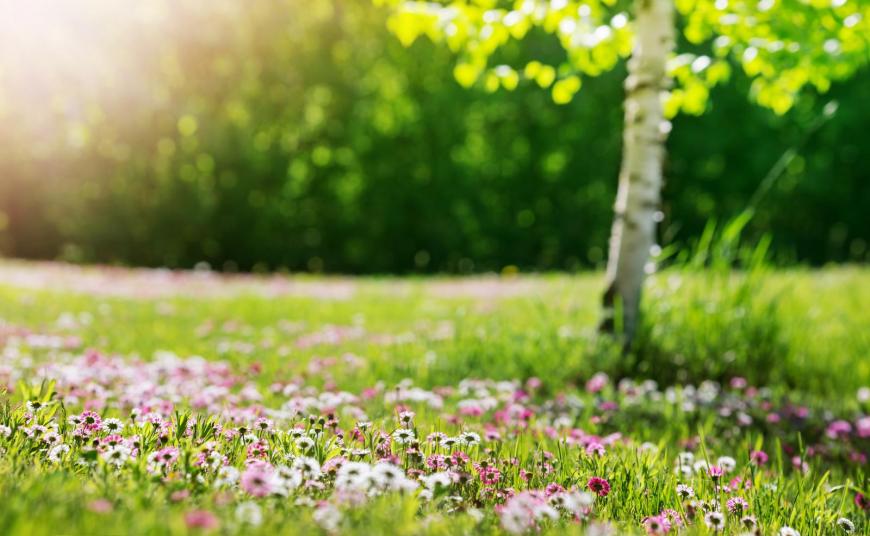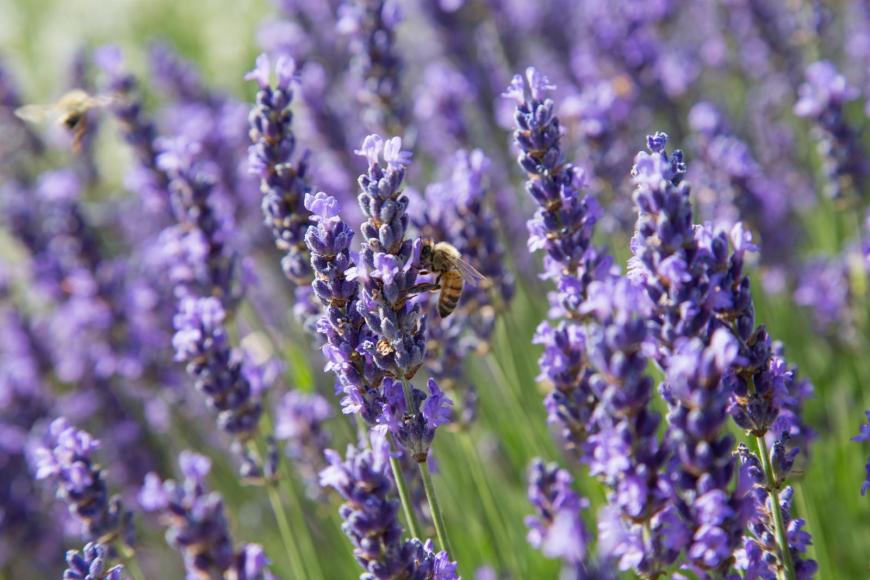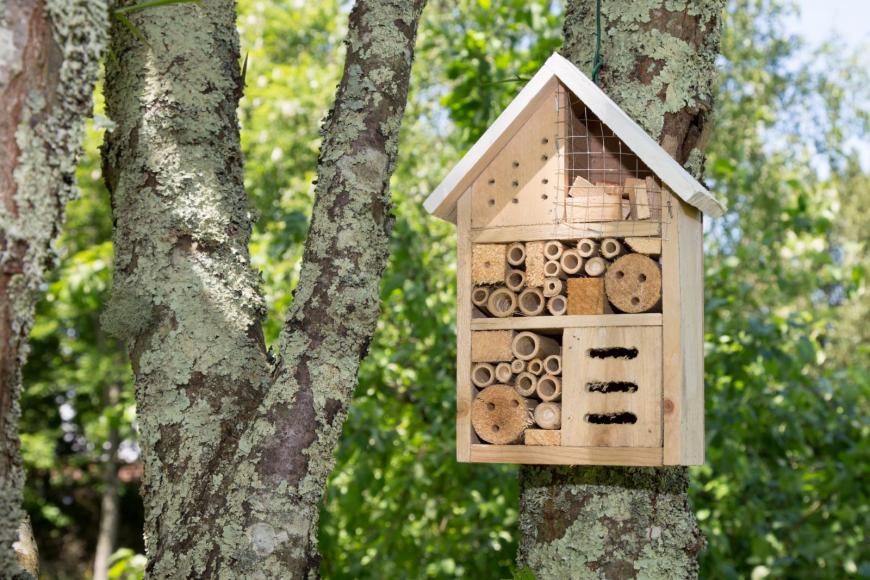
Bees and other pollinators are an essential part of our ecosystems. Many of our food crops depend on insect pollination yet pollinators are in steep decline due to shrinking habitats, the loss of flowering plants and the use of agrochemicals including pesticides. Gardens are extremely important havens for pollinators and whatever the size of your outside space, you can help by growing plants that are rich in nectar and pollen as well as providing a safe habitat. Here are seven ways you can help pollinators this spring.
Garden chemicals have an impact across the entire food chain. Pesticides don’t just kill off ‘the bad guys’ they poison bees and other important pollinators. Instead of using chemicals, you can encourage natural predators by creating a wildlife-friendly garden, with a wide range of different plants and habitats. Healthy plants are naturally more resistant to pests and diseases so focus on creating healthy soil and providing the right conditions for plant growth. It’s also important to make sure that any plants you buy haven’t been treated with pesticides. Unfortunately, many of the plants sold by the main garden centres, d.i.y. chains and supermarkets contain pesticides that are harmful to bees and other wildlife. (These include those that display the RHS “plants for pollinators” symbol on their label. The symbol refers to types of plants that are rich in nectar but it doesn’t address how the plants have been grown or what they have been treated with.) If you want to be sure that the plants you buy for your garden are organic then it’s best to shop at an organic nursery or grow your own plants from organic seed.
If you have a lawn, try cutting it less often and also consider allowing an area to grow wild. You might be surprised by the flowers you see! Daisies, dandelions, white clover and selfheal are among the commonest lawn flowers but you might also see some rarities such as meadow saxifrage, knotted clover and eyebright. Results from Plantlife’s Every Flower Counts survey found that a simple change to cutting the lawn once every four weeks results in enough nectar for ten times more bees and other pollinators. This is because it gives ‘short-grass’ plants like daisies and white clover a chance to flower. If you can, leave an area of unmown grass too. This will boost the diversity of flowers, with nectar-rich plants such as oxeye daisy, field scabious and knapweed increasing the range of nectar sources for different pollinators.

This year the Every Flower Counts survey runs from 22nd to 31st May 2021. Plantlife is encouraging everyone to leave their mowers in the shed for ‘No Mow May’ and then take part in the survey. It only takes a few minutes to do and once you’ve submitted your results, you’ll instantly receive your own ‘Personal Nectar Score’, showing how many bees your lawn can support.
One of the best ways we can help pollinators is by growing flowers rich in the pollen and nectar that they need to thrive. Providing a year-round succession of flowering plants from early spring right through to the winter months helps to ensure that pollen and nectar are always in good supply. There are plenty of plants to choose from. Opt for a mixture of colours, shapes and sizes to cater for different types of bees. Herbs and cottage garden favourites like delphiniums, lupins and hollyhocks are a good choice. Flowers like clover, echinops and scabious are also ideal because they have lots of little flowers close together, offering plenty of nectar in one spot. Include some tubular-shaped flowers like foxgloves, honeysuckle and penstemons to keep long-tongued bumblebees happy. It’s best to avoid annual bedding plants. They’ve often been so intensively bred that they have little value for pollinators and they’ve often been treated with pesticides.
Here are five easy-to-grow plants for pollinators that can be sown or planted now.
Also known as star-flower, Borage is one of the very best plants for bees. It’s an easy to grow annual that has a long flowering period and its nectar-rich flowers are great for attracting short-tailed bumblebees and honey bees. It’s edible too! The leaves have a cucumber taste and the pretty blue flowers can be used in summer drinks and sprinkled on top of salads. Borage self-seeds prolifically and will spread around the garden. This isn’t a problem though as it’s also useful as a mulch and in the compost heap, the stems and leaves being rich in calcium and potassium. Sow borage seeds in pots now, or wait till April and sow them directly in the ground. They like well-drained soil in a sunny spot.

Irresistible to bees as well as to our feline friends, catmint is a low maintenance, perennial plant with a long-flowering season. It loves a sunny position and free-draining soil. Buy organic plants now ready for planting out.
Chives are another edible herb that’s great for bees. They’re perfect for container gardens and can be grown on balconies and in window boxes. The edible, purple pom-pom flowers - which are actually lots of little flowers close together - provide easy access to lots of nectar. Chives like a rich, moist but well-drained soil in sun or partial shade. Sow seeds direct into their final growing position from March onwards. The plants will die down over winter and pop up again in early spring. You can divide the clumps and plant elsewhere when they get too big.
A summer favourite of people and bees! It’s a great source of nectar for butterflies too and there are lots of different lavender varieties to choose from. Plant in pots or in the ground from March through to May. You can raise your own plants from seed but it’s usually easier to buy plants or take cuttings from a friend’s plant in the summer. Just make sure that the plants you buy haven’t been treated with pesticides.

A tall, graceful, late-summer flowering perennial from South America. Verbena Bonariensis is a great plant for the wildlife garden, it’s numerous branched clusters of small, purple flowers attract bees, butterflies and moths. It prefers a well-drained, moist soil in full sun and some shelter from the wind. Seeds can be sown directly in the ground in March and April.
For more bee-friendly plants have a look at the RHS Plants for Pollinators lists.
Growing wildflowers is a great way to attract lots of pollinators into your garden and March is the perfect time to sow them. Create a wildflower border, convert an area of lawn into a mini-meadow or sow some wildflower seeds in containers. Here’s a great guide on how to create a wildflower pollinator patch written by the Channel Island Pollinator Project.
Bees and other pollinators also need water to drink. Ponds with shallow margins are perfect and birdbaths can be adapted by adding some stones for bees and other insects to use as landing pads. You can also make a special bee watering station using a shallow saucer lined with some pebbles or marbles.
A thriving wildlife garden is full of safe nooks and crannies for bees and other pollinators to hide
out and create their nests in. Undisturbed corners, holes in the ground, piles of leaves and under sheds are all places they may choose to nest in. You can also buy ready-made bee hotels to hang up in your garden for bees and other insects to live in. The best nest boxes for bees have an assortment of tubes ranging from 6mm-10mm. Alternatively, have a go at making your own bee hotel.

Get together with neighbours to create as many wildflower patches as possible. Through combining your efforts, you can brighten up your street and help bees at the same time. Join in with Grow Wild’s Bee Street campaign and help turn your neighbourhood into a haven for pollinators.
Loading recent activity...